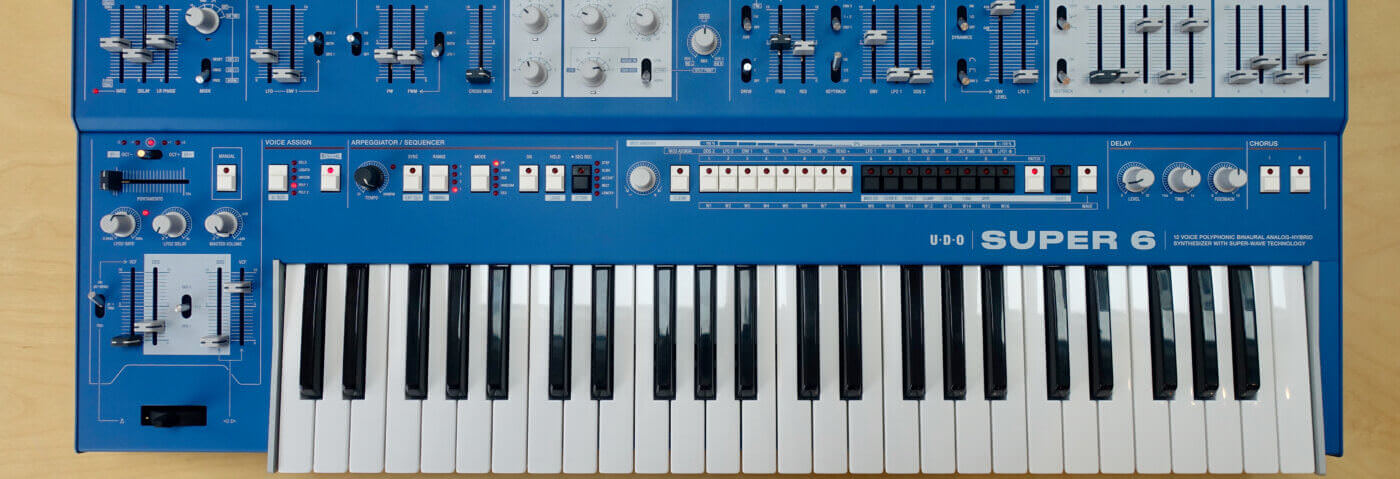Does UDO’s Super 6 hybrid polyphonic synthesizer live up to the hype? Bruce Aisher finds out.
The UDO Audio Super 6 has garnered much interest over the months preceding its release, with much of it based solely on looks and paper specification—and before even a squeal had been heard from the sonic circuitry itself. One should, of course, be wary of hype, but it is always great to see some excitement being placed at the door of an independent synth manufacturer before even its first product has landed. However, this does mean that a Super 6 in the flesh has to live up to the rose-tinted perceptions of all the positive forum chatter.
Perhaps some of the positivity in the pre-release excitement was down to knowing that its creator, George Hearn, had been involved in designing other synths—most notably the Modal 008 (a big and expensive analogue polysynth).
Luckily for both UDO, and all of us, there has been a resurgence in interest in synth hardware over the last few years (and right across the price range). This includes cut-price remakes, cheap and fun new designs, quirky Eurorack modules, and full-on, top-range polys. This interest has also led to old and revered synth chip designs being built again, and designers combining the best of digital and analogue, with the intention of creating designs that are both flexible in scope, but also great-sounding. UDO bring to this another factor—that of performance, or playability. The Super 6 was designed to be a self-contained performance instrument and one where you could interact directly by moving individual front panel controls rather than menu diving. In fact, UDO employed the services of Axel Hartmann (designer of the Waldorf Micro Wave, Moog Little Phatty, and many others) to help in this task. The big question though is, does the UDO Super 6 deliver on its apparent promise?
Kind Of Blue
The Super 6 looks and feels great. The metal case, sturdy controls and high-quality keyboard all give the impression of professionalism and reliability, and if you are less flamboyant in your aesthetic tastes than the striking blue of the review unit you can opt for the more sober grey livery. Either way, although the Super 6 doesn’t copy its design from any one synth, it certainly conjured up memories of my old Roland Jupiter 6, and with a touch of the Juno-106/HS-60 family thrown in. In other words, this places it in the early-mid 80s Japanese school—so no wooden end-cheeks, though no-doubt somebody will create some for it!
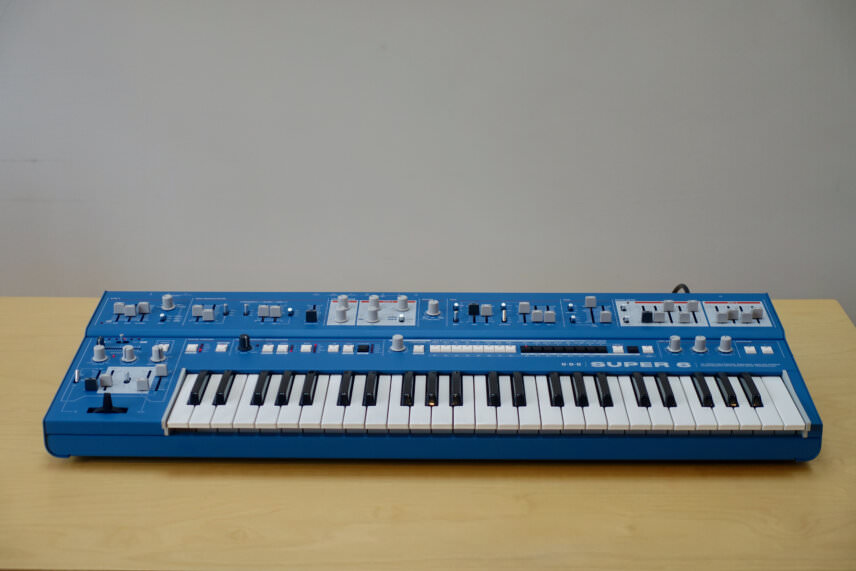
A quick glance at some of the controls will perhaps give the impression that this is an analogue synthesizer, but a closer look will reveal that whilst VCF (Voltage Controlled Filter) and VCA (Voltage Controlled Amplifier) certainly tick this box, there is no mention of VCOs (Voltage Controlled Oscillators) next to the big Super 6 typeface it states that it is a ‘12-voice Polyphonic Binaural Analog-Hybrid Synthesizer With Super-Wave Technology’. So, the Super 6 is a hybrid digital-analogue synth, but in fairness to all concerned, UDO make no attempt to hide this fact.
So why digital? Besides the obvious benefits in terms of tuning stability and control over shape and phase (which are both important when designing a predictable stereo signal path, such as that employed in the Super 6’s default ‘Binaural’ mode), digitally derived waveforms are potentially more flexible in terms of wave shape and modulation possibilities. Historically-speaking, the downside to digital oscillators, in particular, has been the issue of aliasing, whereby frequencies not musically related to the audio output find their way into the signal path. Retro-digital synth fetishists may embrace this as part of the ‘sound’ of a specific synth, but if the aim is to create waveforms that look like their analogue counterparts, then aliasing and other artefacts should be minimised. Things can certainly be improved with good design, higher DSP sample rates and some serious filtering, but all these add to cost. A newer and more effective solution, as employed by UDO here, is the use of FPGA technology. Unlike conventional DSP chips, these act like configurable single-ship digital circuits that can run at a very high sampling rate (MHz rather than kHz) and with multiple processes/circuit pathways running in parallel.
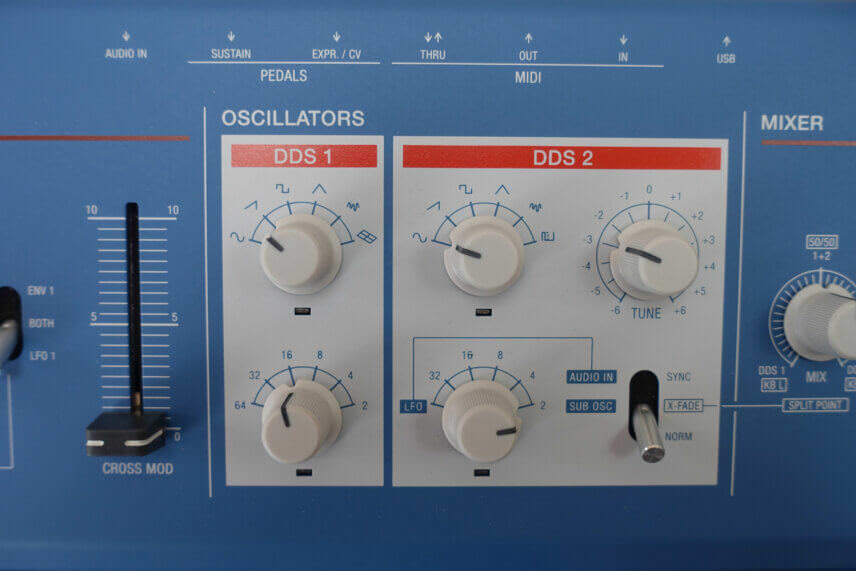
To this end, the Super 6 employs two DDS (Direct Digital Synthesis) oscillators per voice, which are then routed through analogue VCF and VCA stages. Both oscillators are capable of generating four classic analogue-style waveforms (sine, sawtooth, square and triangle), noise or one of 16 onboard custom waveforms. The 16 digital waves are replaceable via USB, but being single-cycle waves, don’t expect this to turn your Super 6 into a hybrid multi-sampler.
Unlike a conventional analogue VCO, DDS1 has a neat trick up its sleeve. By engaging one of the Super DDS modes, the main oscillator is joined by six others that can be progressively tuned either side of the core frequency by using the detune control. This instantly adds thickness and heft to any sound, and whilst it makes classic ‘supersaw’ sounds easy to achieve, it works just as well on subtler tones. DDS2 differs slightly by employing a ‘virtual analogue’ algorithmic core and replacing the Super DDS function with Pulse Width Modulation or the ability to function as an additional LFO. It can also replace the standard waveforms with audio from the rear-panel input or track DSS1 with a Square Wave sub-oscillator and offers classic oscillator sync and independent tuning (although fine-tuning resolution could be improved). The mix control works as you would expect unless you switch to X-Fade mode, whereby the oscillator mix crossfades as you move upwards across the keyboard. As you can tell, a lot of attention has been paid to expanding the usefulness of the oscillator section, whilst allowing it to work in more classic configurations.
Hearing Double
At this stage, it is probably worth addressing the binaural aspect of the synth, as it plays a big part in UDO’s marketing, and is an unusual feature on a synth. Although the term ‘binaural’ simply relates to our two ears, it was originally coined by technology genius Alan Blumlein for his stereophonic sound system. However, it is now commonly associated with recording and playback systems that deliver an immersive three-dimensional sound stage. The Super 6 is more closely tied to the original meaning, and given that that are no controls for panning (left/right or front/back) or height placement, it is perhaps better described as a ‘true stereo’ mode. The Super 6 is a 12-voice synth, but with the Binaural mode engaged it plays voices in pairs (one panned left, and the other to the right). This is not unusual, and something that analogue classics like the Oberheim OB-8 could achieve in a rudimentary way 40 years ago. However, whilst this did fill up the stereo image the effect could vary with each note played due to subtle differences between the analogue voices—which could sometimes lead to unwanted tone variation.
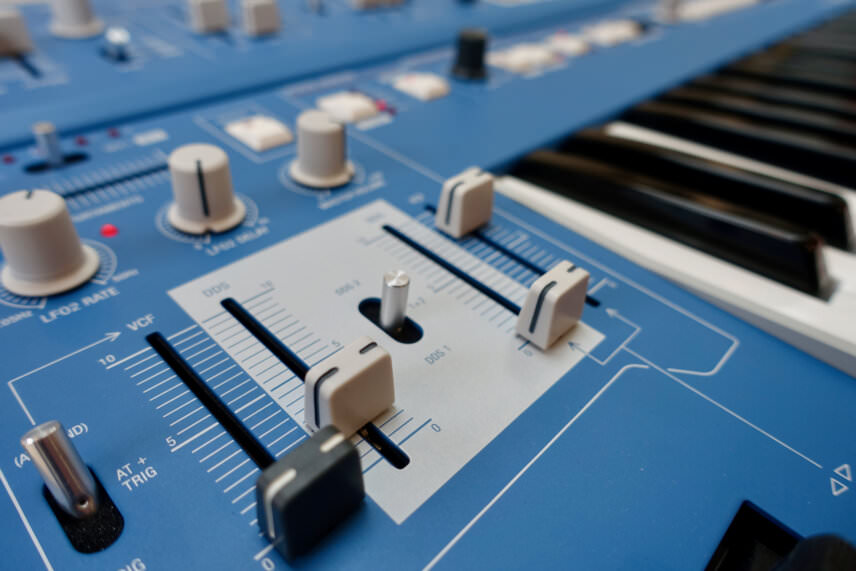
This is where UDO’s digital oscillators come into their own, allowing more direct control to be maintained over voice pairs, ensuring that bass isn’t lost and avoiding unpredictable phasing. This also explains the LR Phase fader in the LFO 1 section, which changes the phase relationship of the modulation between the paired voices. Simple and effective.
Ultimately though, a feature such as this is merely a marketing ploy unless it delivers some meaningful sonic benefit, and luckily it really does. Unlike a chorus effect, Binaural mode works equally well on both rich or purposely thin and harmonically less complex sounds—and it really comes alive when you explore more extensive modulation options. In fact, the Super 6 does also have a built-in chorus, with various modes selected in the manner of the Juno-6/60/106 synths. However, although a nice addition, I found myself preferring the Binaural option for adding thickness or stereo interest, and this is further supported by a unison voice mode (with variable detune). Although in control terms the chorus alludes to earlier Roland classics, it didn’t quite work for me in that respect, though whether this is because it lacks the noise and limitations of its analogue equivalent or differs too much in terms of underlying design requires a little more investigation. I did find that pulsed lines with a fast attack higher up the frequency spectrum resulted in a flam-like repeat (due to the delay times employed). Additional digital effects are provided in the form of a stereo delay line. This is a nice addition and has the ability to be time synchronised to MIDI Clock or Arp/Sequencer tempo and modulated in interesting ways. My wish list here though would have included the addition of variable high/lowpass filters in the feedback loop, and the ability to offset left/right delay times. Nonetheless, it works well and integrates usefully with the rest of the synth.
Super Modulation
The flexible modulation capabilities of the Super 6 have already been alluded to, and this is worth exploring in more detail. There are two dedicated LFOs and two Envelopes, with the first in each case being the more fully-featured. Envelope 1 is a variation on the classic four-stage ADSR, but adds an initial Hold time control, as well as key tracking, inverted and loop modes. Envelope 2 is a conventional ADSR. LFO1 is a multiple waveshape oscillator that can also be pressed into service as an additional audio rate generator (with a pitch tracking option that really comes in handy for FM synthesis). It can be free-running, reset with each note press, or act as a pseudo-envelope by triggering only one full-waveform cycle. LFO1 has hardwired routings, with dedicated controls for modulating pitch, pulse-width, filter cutoff and amplitude. LFO2 is a simpler affair and lives in the Bender Control section, where it can be used to directly control oscillator pitch and filter cutoff. Although the Super 6 has a decent array of pre-configured modulation options, the central patch buttons also act as a matrix for routing eight additional mod signal sources to eight destinations not covered elsewhere. For example, you could use the output of LFO2 to alter the speed of LFO1 or Envelope 1 to control Delay Time. Setting up modulations in this way is pretty straightforward once you get the hang of it. However, UDO have another trick up their sleeve, as it is in fact possible to route the eight sources to any front panel continuous parameter. This really makes the Super 6 a complex modulation monster—though not quite up there with the legendary Oberheim Xpander/Matrix-1, which threw many more LFOs, envelopes and generators into each voice. It would also have been great to have included a way of modulating pan position, though I suspect this may be a limitation of the underlying hardware architecture.
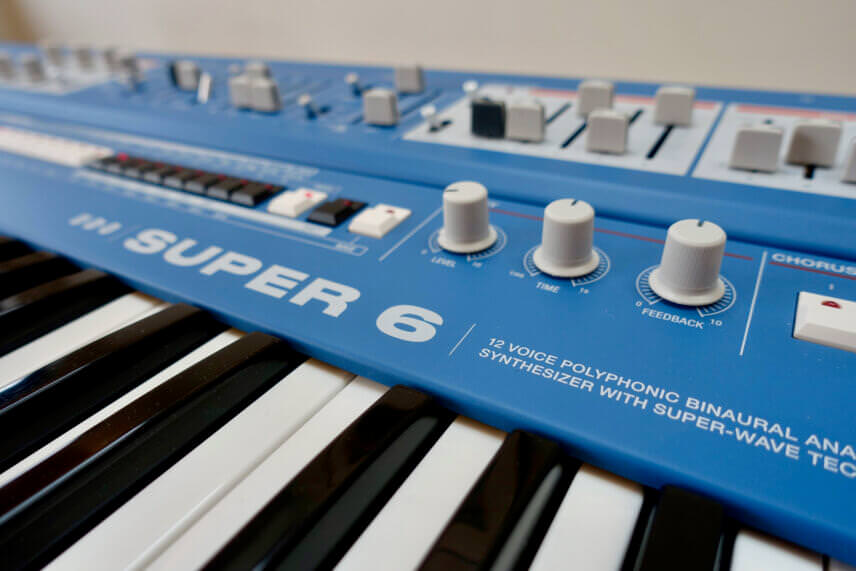
One other area where these older Oberheims led the way was in their numerous filter options. It’s common to find multiple filter types on fully DSP-based synths, but the Super 6 takes a more conservative route by employing a resonant low-pass 24dB/oct design, albeit one employing a modern version of a classic SSM chip. An additional highpass can be engaged, and even offers keyboard tracking, but it would have been great to have had more control over this. Even if a full multi-mode design wasn’t possible, the option to switch to a 12db/octave low-pass filter slope would have been useful.
The Super 6 has a few more tricks up its sleeve, in the form of simple, but effective, arpeggiator and step sequencer. Once you get the hang of the way the sequencer works it is surprisingly flexible and effective and offers more than just conventional fixed-length note sequencing. A SYNC button in the ARP section syncs LFO1 and Delay to the arpeggiator/sequencer, though it would have been nice to have had independent sync controls. Also, it’s a shame that the arpeggiator doesn’t support more complex modes (semi-random, Brownian), though there’s no reason this couldn’t be expanded in a firmware update.
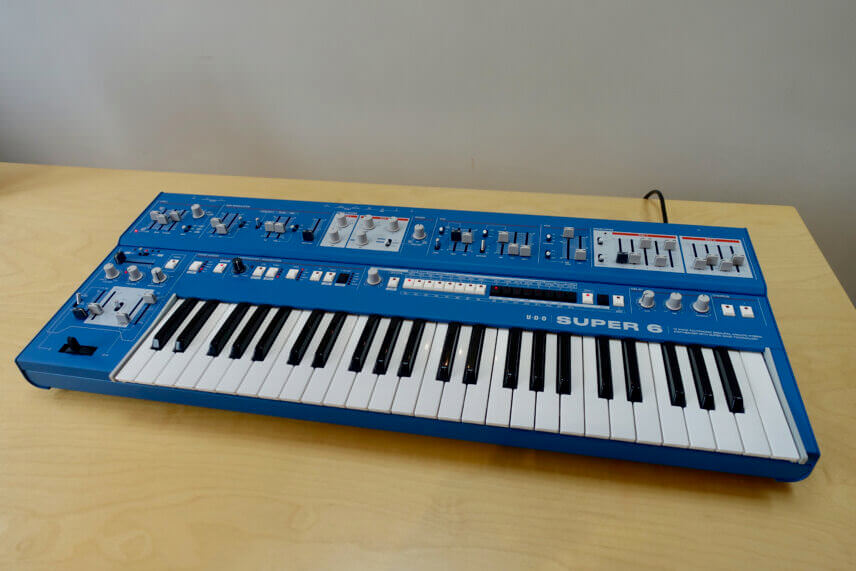
The most noticeable omission on the Super 6, when compared to many modern synths (even fully analogue ones), is the lack of any form of display—not even a simple numeric one. This was obviously a conscious decision, reflecting the fact that Super 6 was designed as an interactive performance synth that intentionally avoided menu diving. However, I do wonder if an alphanumeric display of some kind might have helped usability—if only to provide additional feedback on modulation settings and patch naming. There’s no doubt that adding and accessing additional modes and features can become can be a trickier proposition when faced only with a pre-existing set of labelled controls.
The Bender Control works well for sideways movements but is fiddly, and less effective when pushed upwards. It would also have been good to see alternative portamento modes available in this performance section. That being said, extensive external control over voices can be achieved via MIDI, and MPE is supported.
How Super Is The Six?
Overall, the Super 6 is a great-sounding synth, and after a brief acclimatisation period is quite straightforward to use. It did remind me of various other synths at times, including the DCO-based Juno-106 and JX-10 Super Jupiter, as well as the hybrid Prophet VS. However, it wasn’t limited to these examples, and was certainly capable of covering a wide range of tones. Some may balk at its hybrid approach (mainly the lack of analogue oscillators), but this design decision offers many other sonic benefits. However, this does have to be taken in the broader context—not least the purchase price. At over £2000, the Super 6 is not a casual purchase, though it is on a par with Sequential’s Prophet 6 and others. However, Korg offer a combination of analogue and DSP-programmable oscillators in their Prologue synths that cost half as much. Ultimately, this perhaps means that the UDO Super 6 will be confined to the ‘boutique’ category of modern higher-end synths. That being said, it would make a great visual and functional centrepiece to any studio or live setup and is an impressive entry to the market from newcomers UDO.
Ultimately, this is a synth that should be lauded for bringing something new to the world of polyphony subtractive synthesis and is well worth taking for a test drive.
The Verdict
Price: £2,177
Purchase: UDO Audio Super 6
The Final Word
Easy to use, but with extra sonic complexity only a button press away, the Super 6 sounds great—especially when using its dual voice Binaural mode.
Hand In Hand is the UK distributor for UDO Audio Super 6.
